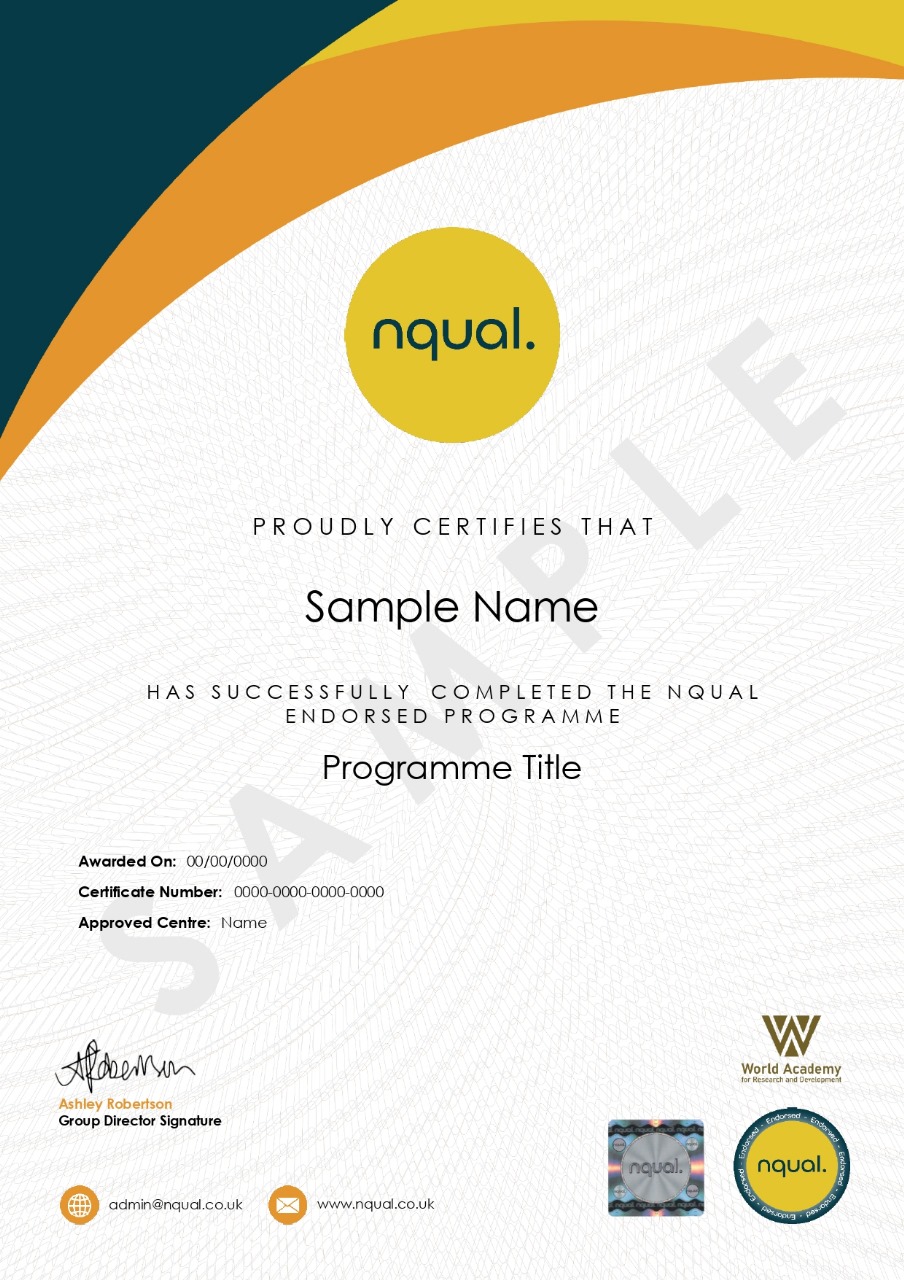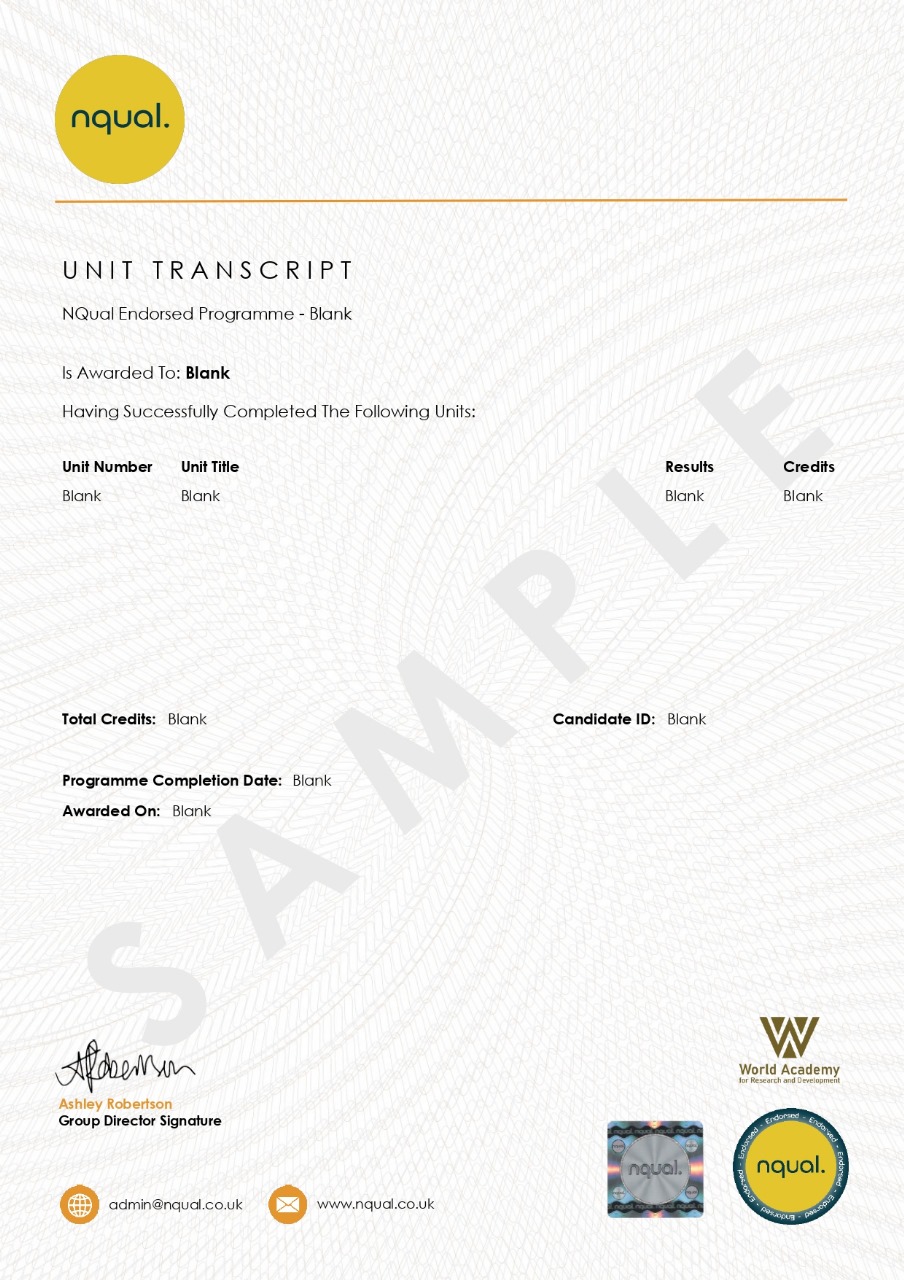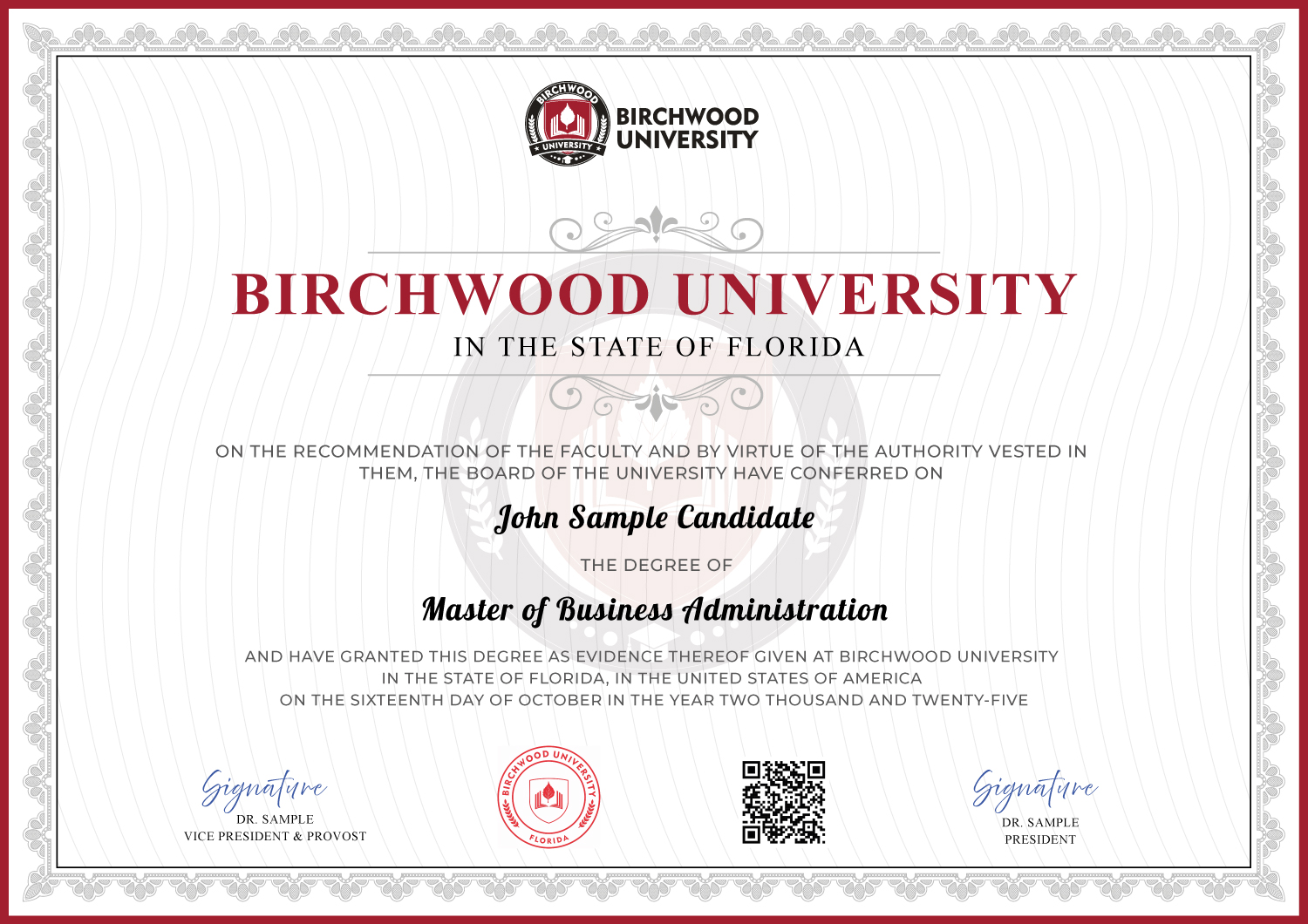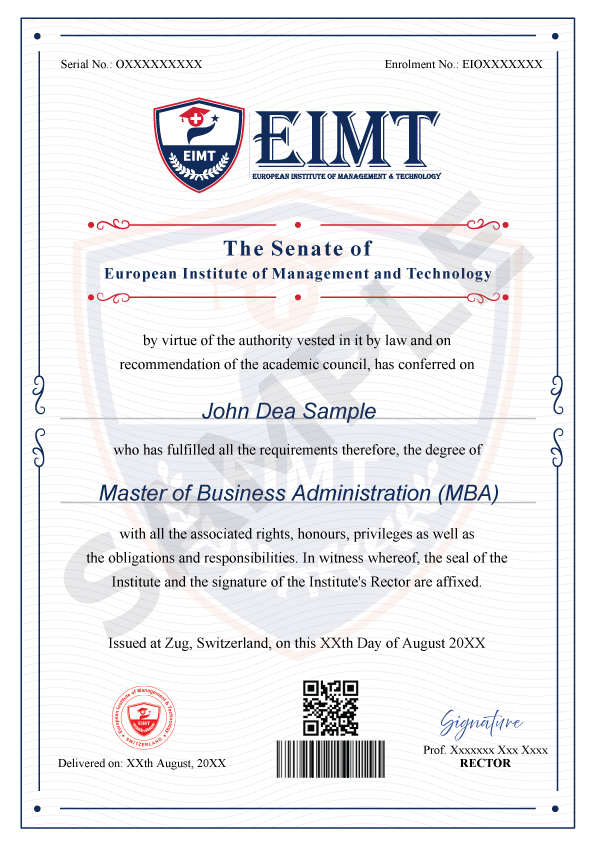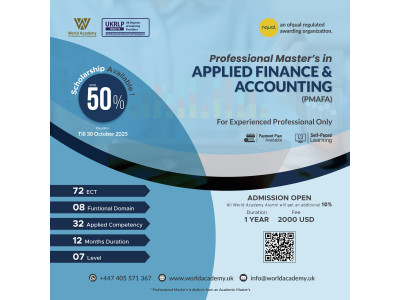
Professional Master’s in Applied Finance and Accounting (PMAFA) Self Paced
Empowering future leaders in justice, equality, and social impact.
Features of the Programme
Regular Fee
2000.00
Partial Scholarship
Available
Intake
Monthly Intake
Programme Duration
12 Months
Live Chat
Available
Everything you need to Know
Introduction
The Professional Master’s in Applied Finance and Accounting (PMAFA) is a comprehensive, industry-aligned program designed to equip finance professionals with the functional expertise, strategic thinking, and applied skills needed to drive financial performance and governance in modern organizations.
Built around eight core Functional Domains, the program integrates foundational accounting practices, advanced financial planning, cost management, regulatory compliance, and enterprise-level financial risk assessment. Each competency area is designed to reflect real-world finance roles and responsibilities, enabling learners to build mastery in both day-to-day financial operations and high-impact strategic decision-making.
Whether preparing financial statements, managing corporate budgets, performing internal audits, or assessing financial risk, this program empowers professionals to lead with confidence, insight, and integrity in a rapidly evolving financial landscape.
Objective
- Build Core Accounting Proficiency
Develop a solid understanding of corporate accounting principles, transaction management, and financial statement preparation to ensure accuracy and transparency in financial reporting.
- Enhance Budgeting and Financial Planning Capabilities
Equip professionals with the tools and frameworks needed to prepare, manage, and evaluate budgets, forecasts, and strategic financial plans aligned with business objectives.
- Strengthen Cost and Performance Management Skills
Apply cost accounting techniques, activity-based costing, and cost-volume-profit analysis to support decision-making, improve profitability, and control expenditures.
- Master Financial Reporting and Compliance Standards
Gain advanced knowledge of IFRS, fair value accounting, and reporting ethics to prepare compliant and high-integrity financial disclosures for internal and external stakeholders.
- Develop Strategic Accounting and Financial Insight
Apply leverage analysis, investment appraisal techniques, and dividend policy decisions to drive business value and support long-term financial strategies.
- Implement Effective Internal Control and Audit Practices
Understand and apply internal audit frameworks, fraud detection methods, and compliance protocols to strengthen governance and protect organizational assets.
- Assess and Mitigate Financial and Operational Risks
Identify, evaluate, and manage credit, operational, and regulatory risks using best-practice tools and enterprise risk management principles.
- Integrate Functional Finance Expertise with Business Strategy
Connect technical accounting skills with strategic business outcomes, enabling professionals to act as financial advisors and partners in performance management and growth.
- Develop Leadership Readiness in Finance Functions
Prepare learners for mid-to-senior level finance roles by building decision-making, analytical, and ethical leadership capabilities across financial domains.
- Promote Continuous Professional Development and Global Competence
Encourage lifelong learning and adaptability through global accounting practices and cross-functional skills applicable across industries and geographies.
Entry Requirements and Eligibility
Entry Requirements:
- Recognized Bachelor Degree in any field, Master's or Recognized Post Graduate Diploma (PGD)
- Recognized Certified Programmes (Specially in FA Field).
- Sufficient English language proficiency.
- At least 2-3 years of working experience.
- Participants must have the facility of smart phone or laptop or computer to maintain the program activity.
Modules
Functional Domain-1: Accounting Operations & Transactional Control
Introduction:
This domain builds the foundation of accounting by focusing on core concepts, principles, and day-to-day functions carried out by accounting professionals. Learners will gain the technical and operational skills required to manage accounting cycles and support financial operations.
Objectives:
- Understand and apply key accounting principles, including double-entry and the accounting equation.
- Accurately record, classify, and post business transactions in ledgers and journals.
- Recognize the functional role of accountants in financial operations, compliance, and reporting.
- Develop proficiency in managing accounts payable, accounts receivable, and general ledger activities.
Applied Competencies (AC):
AC-1: Fundamentals of Corporate Accounting
Introduction:
This competency introduces the foundational structure of accounting systems in a corporate setting. It focuses on the core components of the accounting cycle, helping learners understand how transactions flow from source documents to final trial balances.
Objectives:
- Grasp the foundational structure of corporate accounting systems.
- Identify the role of ledgers, journals, and trial balances in the accounting cycle.
- Apply basic accounting processes to maintain accurate and complete records.
Competencies:
- Ability to explain the accounting equation and its impact on business transactions.
- Proficiency in preparing and interpreting trial balances.
- Skill in identifying components of financial transactions in corporate settings.
AC-2: Different Accounting Concepts
Introduction:
This area covers essential accounting concepts such as matching, consistency, going concern, and prudence. It ensures that learners can apply these principles appropriately in the preparation and interpretation of financial records.
Objectives:
- Understand core accounting concepts such as accrual, consistency, going concern, and matching.
- Apply accounting standards and concepts in financial recording.
- Distinguish between cash-based and accrual-based accounting systems.
Competencies:
- Ability to apply relevant concepts in transaction recognition and classification.
- Skill in explaining and justifying the use of accounting conventions.
- Competence in identifying errors resulting from improper application of accounting principles.
AC-3: Role and Functions of Accountant in organization
Introduction:
This competency explores the evolving role of the accountant—from transactional processor to strategic business partner. It emphasizes how accounting functions integrate with financial planning, reporting, and compliance efforts across departments.
Objectives:
- Define the strategic and operational role of accountants in supporting business decision-making.
- Understand the intersection between accounting, finance, audit, and compliance functions.
- Analyze the value of accounting in performance monitoring and internal controls.
Competencies:
- Ability to describe and differentiate various accountant roles in a corporate structure.
- Skill in integrating accounting functions with broader financial operations.
- Capability to assess how accounting contributes to governance and reporting integrity.
AC-4: Recording and classifying business transactions
Introduction:
Focusing on technical accuracy, this competency teaches learners how to systematically record financial transactions and classify them correctly across ledgers. It provides hands-on experience in double-entry accounting and ledger maintenance.
Objectives:
- Demonstrate accuracy in recording business transactions in journals and ledgers.
- Apply appropriate classification of assets, liabilities, equity, income, and expenses.
- Ensure compliance with financial standards in transaction documentation.
Competencies:
- Proficiency in using double-entry systems for transaction recording.
- Skill in classifying and coding transactions for accurate financial reporting.
- Accuracy in posting entries to general and subsidiary ledgers with reconciliation capability.
Functional Domain-2: Financial Planning & Budgeting
Introduction:
This domain equips learners with tools and techniques for effective financial planning, resource allocation, and budget control. It bridges operational finance with long-term strategic goals.
Objectives:
- Learn to design and manage budgets aligned with organizational goals.
- Apply forecasting models to support resource planning and performance tracking.
- Analyze variances between actual and budgeted results to support decision-making.
- Integrate budgeting and planning into broader financial strategy and control frameworks.
Applied Competencies (AC):
AC-1: Introduction to Budgeting
Introduction:
This competency introduces budgeting as a key financial management tool. Learners explore the types, purposes, and processes of budgeting to understand how it supports planning, coordination, and control within an organization.
Objectives:
- Understand the role and purpose of budgeting in financial planning.
- Identify types of budgets and their relevance in different business contexts.
- Establish a structured process for budget preparation and approval.
Competencies:
- Ability to distinguish between operating, capital, and flexible budgets.
- Skill in outlining the key steps of a budgeting process.
- Understanding of the relationship between strategic goals and budget formulation.
AC-2: Corporate Financial Planning
Introduction:
This area focuses on aligning financial plans with strategic objectives. Learners will explore how to create integrated financial plans that incorporate forecasts, assumptions, and department-level inputs to inform business decisions.
Objectives:
- Align financial planning with long-term business strategies.
- Support departmental planning through integrated budgeting models.
- Use forecasting tools to anticipate revenue and expenditure trends.
Competencies:
- Proficiency in applying top-down and bottom-up financial planning models.
- Ability to integrate departmental plans into consolidated financial forecasts.
- Skill in adjusting financial plans based on historical and predictive trends.
AC-3: Preparing & Managing Budgeting to Support Financial Plans
Introduction:
This competency equips learners with skills to monitor, analyze, and adjust budgets during the execution phase. Emphasis is placed on variance analysis, resource reallocation, and performance tracking to improve financial discipline.
Objectives:
- Monitor budget performance against actual financial outcomes.
- Identify variances and develop corrective actions.
- Coordinate with stakeholders to ensure budget adherence and realignment.
Competencies:
- Capability to prepare variance analysis reports for decision-makers.
- Skill in conducting root-cause analysis for budget deviations.
- Proficiency in revising budgets during the financial cycle based on updated information.
AC-4: Managing & Controlling Cash Flow to Support Financial Plans
Introduction:
This area teaches learners how to monitor and manage a company's cash flow to maintain liquidity and operational efficiency. It covers forecasting, working capital management, and the use of financial data to ensure short- and long-term solvency.
Objectives:
- Understand the drivers of business cash inflows and outflows.
- Forecast short-term and long-term cash positions to ensure liquidity.
- Implement controls to manage working capital efficiently.
Competencies:
- Ability to develop and interpret cash flow forecasts.
- Competence in managing receivables, payables, and inventory to optimize cash.
- Understanding of how to use cash flow data for operational and strategic decisions.
Functional Domain-3: Financial Statement Preparation
Introduction:
This domain focuses on the preparation of core financial statements—Balance Sheet, Income Statement, and Cash Flow Statement—ensuring learners can translate raw financial data into structured financial outputs.
Objectives:
- Understand the structure and purpose of standard financial statements.
- Prepare accurate financial statements in compliance with accounting standards.
- Apply adjusting entries such as accruals, prepayments, and provisions.
- Perform bank reconciliations and closing procedures for reporting periods.
Applied Competencies (AC):
AC-1: Preparation of Financial Statements
Introduction:
This competency focuses on compiling and presenting financial statements (P&L, Balance Sheet, Cash Flow Statement) that provide a true and fair view of the organization’s financial position. It includes classification, summarization, and period-end reporting procedures in compliance with accounting frameworks.
Objectives:
- Prepare income statements, balance sheets, and cash flow statements from trial balances and adjusted entries.
- Understand the structure, components, and interdependencies of key financial statements.
- Ensure that financial statements meet statutory, regulatory, and stakeholder reporting requirements.
Competencies:
- Ability to prepare final accounts in accordance with standard formats.
- Skill in linking financial statements using adjustments and period-end balances.
- Competence in ensuring consistency and integrity across financial reports.
AC-2: Accrual and Prepayments
Introduction:
This competency focuses on applying accrual accounting principles to ensure financial statements reflect the correct accounting period. Learners will make end-of-period adjustments for accrued revenues/expenses and prepayments.
Objectives:
- Understand the accounting treatment for accrued income, accrued expenses, and prepayments.
- Apply adjustments to financial statements to reflect earned and incurred values.
- Distinguish between cash-based and accrual-based results and their implications on reporting.
Competencies:
- Ability to calculate and record adjusting entries for accruals and prepayments.
- Skill in recognizing the impact of timing differences on financial results.
- Proficiency in ensuring compliance with the matching and revenue recognition principles.
AC-3: Bad and Doubtful Debts
Introduction:
This competency develops the learner’s ability to account for irrecoverable debts and establish provisions for doubtful debts. It ensures accurate asset valuation and income reporting.
Objectives:
- Understand the process for identifying, writing off, and provisioning for bad debts.
- Analyze how doubtful debts affect the income statement and receivables.
- Record journal entries for bad debt expense, provision creation, and recovery.
Competencies:
- Skill in estimating provisions based on aging analysis or historical data.
- Ability to prepare adjusting entries for bad debt expense and provision accounts.
- Understanding of the financial impact of uncollectible receivables on business decisions.
AC-4: Bank Reconciliations
Introduction:
This competency emphasizes the importance of reconciling the organization’s bank records with its cash book. It enhances accuracy in cash reporting and internal control over funds.
Objectives:
- Identify timing and recording differences between bank statements and internal records.
- Prepare accurate bank reconciliation statements to ensure consistency and integrity.
- Resolve discrepancies and understand their impact on cash flow and reporting.
Competencies:
- Ability to match transactions, identify variances, and prepare reconciliation statements.
- Skill in investigating and adjusting errors related to unpresented cheques, direct debits, and deposits in transit.
- Competence in maintaining accurate and up-to-date cash balances for reporting and decision-making.
Functional Domain-4: Cost & Management Accounting
Introduction:
This domain introduces cost analysis tools and management accounting practices used to support operational efficiency, pricing decisions, and strategic resource utilization.
Objectives:
- Apply cost classification and allocation methods in business operations.
- Use cost-volume-profit (CVP) analysis for planning and decision-making.
- Implement activity-based costing (ABC) and activity-based management (ABM) systems.
- Support strategic cost management to enhance productivity and profitability.
Applied Competencies (AC):
AC-1: Introduction to Management Accounting
Introduction:
This competency builds the foundation for management accounting as a tool for internal decision-making. It introduces learners to the distinction between financial and management accounting and the various types of costs and cost behavior critical to operational control.
Objectives:
- Understand the purpose and scope of management accounting.
- Classify costs based on behavior, traceability, and function.
- Explain the role of management accounting in decision-making and control.
Competencies:
- Ability to differentiate between fixed, variable, direct, and indirect costs.
- Skill in applying cost classifications to production and service environments.
- Understanding of the contribution of management accounting to internal financial control.
AC-2: Activity-Based Costing (ABC)
Introduction:
This competency develops the learner’s ability to apply activity-based costing and management techniques. It focuses on identifying cost drivers, allocating overheads accurately, and using cost data for performance improvement.
Objectives:
- Understand the principles and process of activity-based costing.
- Allocate indirect costs to products or services using cost drivers.
- Apply ABM techniques to optimize resource usage and reduce waste.
Competencies:
- Ability to identify relevant cost drivers for complex operations.
- Skill in preparing ABC-based cost sheets for products or services.
- Competence in using ABM insights to improve operational efficiency.
AC-3: Cost-Volume-Profit (CVP) Analysis
Introduction:
This competency focuses on the application of CVP analysis as a financial planning tool. Learners assess how changes in cost structures, volume, and pricing affect business profitability and break-even thresholds.
Objectives:
- Calculate break-even points and margin of safety using CVP models.
- Evaluate the impact of cost and sales changes on profitability.
- Use CVP analysis to support pricing, expansion, and cost-reduction decisions.
Competencies:
- Proficiency in preparing break-even and contribution analysis reports.
- Skill in interpreting the relationship between cost structures and financial risk.
- Ability to apply CVP models in scenario-based decision-making.
AC-4: Strategic Cost Management
Introduction:
This competency provides advanced tools for aligning cost structures with business strategy. It explores cost control mechanisms, benchmarking, and long-term cost reduction initiatives to enhance competitiveness.
Objectives:
- Analyze cost behavior and its strategic implications across functions.
- Identify areas for cost optimization using benchmarking and ratio analysis.
- Develop cost strategies that support sustainable profitability and value creation.
Competencies:
- Capability to conduct cost-benefit and value chain analysis.
- Competence in applying tools like target costing, kaizen costing, and life-cycle costing.
- Ability to integrate cost strategy with business planning and performance frameworks.
Functional Domain-5: Financial Reporting and Analysis
Introduction:
This domain covers financial reporting principles and techniques to evaluate business performance. It includes the application of global standards and ethical practices.
Objectives:
- Apply International Financial Reporting Standards (IFRS) in financial reports.
- Conduct ratio analysis, trend analysis, and performance evaluations.
- Interpret fair value accounting principles and their corporate applications.
- Uphold ethics and transparency in financial reporting and disclosures.
Applied Competencies (AC):
AC-1: International Financial Reporting Standards (IFRS)
Introduction:
This competency focuses on the understanding and application of IFRS in preparing and presenting financial statements. Learners will become familiar with core IFRS standards relevant to income recognition, asset valuation, liabilities, and equity disclosures.
Objectives:
- Understand the structure and objectives of IFRS and its global impact.
- Apply key IFRS standards in the preparation of financial reports.
- Ensure compliance with disclosure requirements and reporting integrity.
Competencies:
- Ability to interpret and apply IFRS principles in financial reporting.
- Competence in differentiating between IFRS and local GAAP frameworks.
- Skill in preparing compliant financial statements that meet global standards.
AC-2: Fair Value Accounting
Introduction:
This competency develops the learner’s ability to apply fair value measurement principles for assets and liabilities. It emphasizes valuation techniques and the impact of fair value adjustments on financial statements.
Objectives:
- Understand the concept of fair value and its importance in modern accounting.
- Apply valuation models for financial and non-financial items.
- Incorporate fair value changes into financial reporting with proper disclosure.
Competencies:
- Skill in applying Level 1, Level 2, and Level 3 fair value hierarchy techniques.
- Ability to adjust asset and liability values based on market-based information.
- Competence in reporting unrealized gains/losses transparently and accurately.
AC-3: Financial Analysis and Planning
Introduction:
This competency covers financial ratio analysis, trend evaluation, and performance measurement. Learners will use financial data to assess organizational health, compare performance over time, and support decision-making.
Objectives:
- Use financial ratios to evaluate liquidity, profitability, solvency, and efficiency.
- Conduct trend and comparative analysis across multiple reporting periods.
- Interpret financial results to support internal and external stakeholder decisions.
Competencies:
- Proficiency in calculating and interpreting key financial ratios.
- Ability to identify performance trends and underlying financial risks.
- Skill in presenting financial insights through dashboards and reports.
AC-4: Financial Reporting Ethics and Compliance
Introduction:
This competency highlights the ethical considerations and regulatory expectations in financial reporting. It reinforces the importance of integrity, transparency, and professional ethics in maintaining stakeholder trust.
Objectives:
- Understand ethical responsibilities in financial reporting and disclosures.
- Identify common ethical dilemmas and fraudulent practices in reporting.
- Apply compliance frameworks to uphold governance and accountability.
Competencies:
- Ability to recognize and address ethical breaches in financial reporting.
- Competence in applying corporate governance principles and codes of conduct.
- Understanding of regulatory reporting obligations and ethical audit trails.
Functional Domain-6: Strategic Accounting & Corporate Finance Decisions
Introduction:
This domain focuses on the strategic aspects of accounting and financial decision-making, preparing professionals to lead in high-level financial planning, investment analysis, and corporate finance.
Objectives:
- Analyze the impact of operating and financial leverage on business risk.
- Evaluate investment decisions using NPV, IRR, and other financial metrics.
- Assess dividend policies and their effect on shareholder value.
- Interpret foreign exchange impacts on international business operations.
Applied Competencies (AC):
AC-1: Operating and Financial Leverage
Introduction:
This competency introduces the concept of leverage and its impact on a firm’s profitability and risk profile. Learners will explore the relationship between fixed costs, variable costs, and earnings volatility, enabling them to assess risk implications tied to cost structures and financing decisions.
Objectives:
- Distinguish between operating leverage and financial leverage.
- Calculate degrees of leverage and assess their impact on earnings.
- Use leverage analysis to guide strategic cost and financing decisions.
Competencies:
- Ability to compute and interpret degree of operating and financial leverage (DOL, DFL).
- Skill in evaluating how leverage amplifies business risk under different cost structures.
- Competence in using leverage metrics to assess capital structure efficiency.
AC-2: Foreign Exchange Rates
Introduction:
This competency equips learners to manage and account for the effects of foreign currency transactions, exchange rate fluctuations, and currency translation in financial statements. It emphasizes risk analysis and strategic response in international operations.
Objectives:
- Understand the accounting treatment of foreign currency transactions and translations.
- Evaluate the impact of exchange rate changes on financial performance.
- Apply hedging strategies and interpret their implications in financial reporting.
Competencies:
- Ability to record and adjust transactions involving foreign currency under IFRS/GAAP.
- Competence in analyzing translation exposure and economic exposure.
- Skill in using forward contracts or natural hedges in managing FX risk.
AC-3: Dividend-Policy & Decisions
Introduction:
This competency explores corporate dividend policy and its influence on capital allocation and shareholder wealth. Learners will analyze the strategic trade-offs between retention and distribution of profits and their long-term implications.
Objectives:
- Understand types of dividend policies and their strategic objectives.
- Analyze the impact of dividend policy on firm valuation and investor sentiment.
- Evaluate payout decisions in the context of profitability, liquidity, and growth stage.
Competencies:
- Ability to compare residual, stable, and hybrid dividend models.
- Skill in linking dividend decisions to earnings trends, cash flow, and capital needs.
- Competence in advising on dividend declarations and reinvestment strategies.
AC-4: Investment Decision Rules
Introduction:
This competency focuses on capital budgeting techniques used to assess the viability and value of long-term investment projects. It covers practical application of financial appraisal tools to support high-stakes investment decisions.
Objectives:
- Apply NPV, IRR, Payback Period, and Profitability Index in investment evaluations.
- Assess project risk using sensitivity and scenario analysis.
- Interpret investment results in alignment with strategic priorities and constraints.
Competencies:
- Proficiency in preparing investment appraisal models and cash flow projections.
- Skill in comparing mutually exclusive projects using financial metrics.
- Ability to present and justify investment decisions to stakeholders and boards.
Functional Domain-7: Internal Control, Audit & Regulatory Compliance
Introduction:
This domain develops capabilities in designing, implementing, and auditing internal control systems, while ensuring compliance with regulatory standards and ethical frameworks.
Objectives:
- Understand audit principles and frameworks for internal control evaluation.
- Identify and mitigate financial fraud and operational risk through internal audits.
- Prepare audit evidence and documentation in line with audit standards.
- Ensure organizational compliance with financial regulations and reporting codes.
Applied Competencies (AC):
AC-1: Audit, Control & Compliance
Introduction:
This competency introduces the broader governance landscape, emphasizing the role of internal control systems, audit compliance, and regulatory obligations in corporate environments. Learners will grasp how audit systems support financial transparency and reduce risk.
Objectives:
- Understand the scope and objectives of internal control and compliance frameworks.
- Evaluate financial and operational controls using audit checklists and standards.
- Align internal audit processes with regulatory and corporate governance requirements.
Competencies:
- Ability to design basic control frameworks and compliance policies.
- Skill in interpreting regulatory audit requirements (e.g., SOX, COSO, IFRS standards).
- Competence in applying risk-based audit approaches in compliance evaluation.
AC-2: Introduction to Internal Audit
Introduction:
This competency explores the internal audit process, including audit planning, scoping, and execution. Learners will understand the role of auditors in identifying control gaps, recommending improvements, and ensuring organizational accountability.
Objectives:
- Identify the phases of the internal audit lifecycle.
- Conduct risk assessments to develop internal audit plans.
- Communicate audit findings and recommend action plans to management.
Competencies:
- Proficiency in developing internal audit scopes and schedules.
- Skill in identifying and documenting internal control deficiencies.
- Ability to deliver audit reports that meet professional audit communication standards.
AC-3: Internal Control & Fraud Detection
Introduction:
This competency emphasizes the design of effective internal controls to detect and prevent fraudulent activities. Learners will explore case-based examples and implement control procedures that safeguard organizational assets and maintain financial integrity.
Objectives:
- Define types of fraud and common fraud risk indicators.
- Design internal controls tailored to fraud-prone areas of financial operations.
- Apply investigative techniques for detecting suspicious transactions or anomalies.
Competencies:
- Skill in performing fraud risk assessments and control testing.
- Ability to identify red flags in accounting and cash handling processes.
- Proficiency in recommending control enhancements to mitigate fraud risks.
AC-4: Audit Evidence & Documentation
Introduction:
This competency focuses on the collection, organization, and analysis of audit evidence in line with professional standards (e.g., ISA, AICPA, IIA). It trains learners in audit documentation techniques that support transparency and accountability.
Objectives:
- Understand the types and sources of audit evidence.
- Prepare working papers that meet audit standards and legal defensibility.
- Ensure audit documentation aligns with ethical principles and due diligence.
Competencies:
- Competence in evaluating sufficiency and reliability of audit evidence.
- Ability to structure audit documentation for clarity and audit trail assurance.
- Proficiency in complying with ethical guidelines and confidentiality standards in audit work.
Functional Domain-8: Financial Risk Management
Introduction:
This domain addresses the identification, assessment, and mitigation of financial risks in a corporate environment. It prepares learners to build resilience through structured risk management strategies.
Objectives:
- Identify key categories of financial risk, including credit, operational, and market risks.
- Apply risk assessment tools to evaluate and quantify exposures.
- Implement strategies for regulatory compliance and risk governance.
- Contribute to enterprise risk management and continuity planning frameworks.
Applied Competencies (AC):
AC-1: Introduction to Financial Risk Management
Introduction:
This competency sets the foundation by introducing the concept of financial risk, its types, and how it impacts strategic and operational decisions. Learners explore the frameworks and tools that support proactive risk identification and governance.
Objectives:
- Define different types of financial risk: credit, market, operational, and liquidity.
- Explore key frameworks (e.g., COSO, ISO 31000) used in enterprise risk management.
- Examine the strategic value of risk mitigation in decision-making processes.
Competencies:
- Ability to categorize and explain types of risk across business functions.
- Understanding of ERM principles and organizational risk mapping.
- Skill in integrating risk thinking into corporate strategy and planning.
AC-2: Credit Risk Management
Introduction:
This competency focuses on credit risk analysis and management. It trains learners to assess counterparty creditworthiness, manage exposure, and apply credit risk models to lending, investment, and customer relationships.
Objectives:
- Evaluate the creditworthiness of clients and suppliers.
- Apply credit scoring models and risk-adjusted pricing techniques.
- Manage credit limits and policies to reduce default risk.
Competencies:
- Skill in interpreting financial ratios for credit assessment.
- Proficiency in designing credit policies and exposure controls.
- Competence in applying Basel III/IV principles in credit risk regulation.
AC-3: Operational Risk Management
Introduction:
This competency explores risks arising from internal processes, systems, people, or external events. It emphasizes proactive controls, risk mapping, and mitigation strategies to protect the business from operational disruptions.
Objectives:
- Identify sources of operational risk across departments.
- Conduct root cause and scenario analysis for risk control.
- Design internal controls and monitoring tools for operational resilience.
Competencies:
- Competence in creating operational risk registers and control matrices.
- Ability to apply Key Risk Indicators (KRIs) and risk dashboards.
- Skill in documenting and managing incidents and near-misses.
AC-4: Regulatory and Compliance Risk
Introduction:
This competency addresses financial compliance requirements and the implications of failing to meet regulatory obligations. Learners gain knowledge in compliance monitoring, reporting, and policy development to manage legal and reputational risks.
Objectives:
- Understand global regulatory frameworks (e.g., AML, FATCA, SOX).
- Implement compliance policies and internal audit protocols.
- Monitor and report regulatory adherence and incidents.
Competencies:
- Proficiency in drafting compliance manuals and escalation procedures.
- Ability to lead internal reviews and regulatory audits.
- Competence in mapping compliance obligations across jurisdictions.
Details
Course overview:
- Total Functional Domain: 08
- Every Functional Domain has 04 Applied Competencies
- Total Applied Competency: 32
- Per Competency: 02 ECT
- Capstone Project Work (CPW): 08
- Total ECT: 4*2*8+8=72
- Study Mode: Self-Paced Learning System (Online-Distance Learning)
- Duration: 12 Months.
- Assignment: Each Unit has 01 (One) Final Assignment.
- Research Project Work: One Research Project Work needs to be submitted.
Required Documents for Admission:
- Education Certificates.
- Latest CV/Resume.
- Personal Statement (500 words).
- Passport Copy.
- Passport Size Photo (jpg. format).
- Reference Letters.
Grading Systems:
Pass:
- Higher Distinction: 90-100%
- Distinction: 80-89%
- First Division: 70-79%
- Second Division: 60-69%
- Satisfactory: 50-59%
Fail:
- Unsatisfactory: 49% and Below.
FAQ
Will Update


